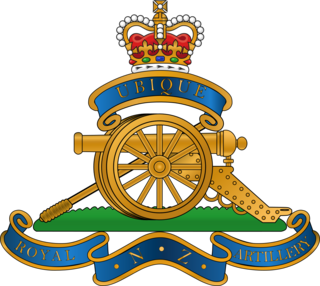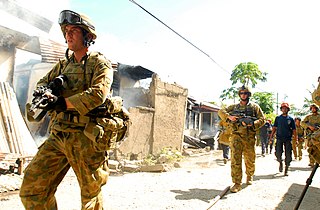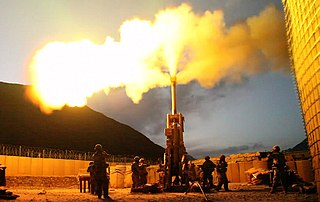Related Research Articles

The 9th Infantry Division is an inactive infantry division of the United States Army. It was formed as the 9th Division during World War I, but never deployed overseas. In later years it was an important unit of the U.S. Army during World War II and the Vietnam War. It was also activated as a peacetime readiness unit from 1947 to 1962 at Fort Dix, New Jersey as a Training Division, West Germany, and Fort Carson, Colorado as a Full Combat Status Division, and from 1972 to 1991 as an active-duty infantry division at Fort Lewis, Washington. The division was inactivated in December 1991.

The Royal Regiment of New Zealand Artillery is the artillery regiment of the New Zealand Army. It is effectively a military administrative corps, and can comprise multiple component regiments. This nomenclature stems from its heritage as an offshoot of the British Army's Royal Artillery. In its current form it was founded in 1947 with the amalgamation of the regular and volunteer corps of artillery in New Zealand. In 1958 in recognition of services rendered it was given the title the Royal Regiment of New Zealand Artillery.

This article describes the current structure of the Australian Army. It includes the army's order of battle and the headquarters locations of major units. Members of the Australian Army also serve within joint units of the Australian Defence Force which fall outside the direct command of the Australian Army.

Operation Astute was an Australian-led military deployment to East Timor to quell unrest and return stability in the 2006 East Timor crisis. It was headed by Brigadier Bill Sowry, and commenced on 25 May 2006 under the command of Brigadier Michael Slater. The operation was established at the request of East Timor's government, and continued under an understanding reached between Australia, East Timor, and the United Nations, with the United Nations Integrated Mission in East Timor supporting and helping to develop East Timor's police force. Other countries deploying soldiers to East Timor include Malaysia, New Zealand and East Timor's former colonial power Portugal, operating under independent command.

Below is an estimated list of the major units deployed within the Multi-National Force – Iraq and other United States military units that were operating in Iraq under the U.S. Central Command (USCENTCOM) in 2009, during the Iraq War.
This is the Operation Herrick ground order of battle, which lists any British ground forces that have taken part in the duration of Operation Herrick between 2002 and 2014.
In September 1939, the British Army was in process of expanding their anti-aircraft and mobile assets. Among these new changes was the formation of Anti-Aircraft Command which was formed on 1 April 1939, and the 1st Armoured Division formed in 1937. The list below will include the British Army units, colonial units, and those units which were in the process of formation.

The 1st Brigade is currently the largest unit of the New Zealand Army, and contains most of the army's deployable units. The brigade was formed on 13 December 2011 by amalgamating the 2nd Land Force Group and 3rd Land Force Group. Its establishment formed part of the 'Army 2015' package of reforms.
The Northern Army Group (NORTHAG) was a NATO military formation comprising five Army Corps from five NATO member nations. During the Cold War NORTHAG was NATO's forward defence in the Northern half of the Federal Republic of Germany (FRG). The Southern half of the Federal Republic of Germany was to be defended by the four Army Corps of NATO's Central Army Group (CENTAG). During wartime NORTHAG would command four frontline corps and one reserve corps. Air support was provided by Second Allied Tactical Air Force.
The Central Army Group (CENTAG) was a NATO military formation comprising four Army Corps from two NATO member nations comprising troops from Canada, West Germany and the United States. During the Cold War, CENTAG was NATO's forward defence in the southern half of the Federal Republic of Germany (FRG). The northern half of the FRG was defended by the four Army Corps of NATO's Northern Army Group (NORTHAG). During wartime, CENTAG would command four frontline corps. Air support was provided by Fourth Allied Tactical Air Force.

This article describes the current structure of the New Zealand Army. It includes the army's order of battle and the headquarters locations of major units.

The Desert Column was a First World War British Empire army corps which operated in the Sinai and Palestine Campaign from 22 December 1916. The Column was commanded by Lieutenant General Philip W. Chetwode and formed part of Eastern Force. When Chetwode took command of Eastern Force after the Second Battle of Gaza, Harry Chauvel took command and oversaw the expansion of the column to three divisions.

Forward Operating Base Bostick, previously called FOB Naray, was a U.S. military outpost in the Kunar Province of Afghanistan. In July 2008, the name of the base was changed in memory of Major Thomas G. Bostick Jr. of Llano, Texas, who was killed in action.

This is an order of battle listing the Allied and Ottoman forces involved in the Gallipoli campaign during 1915.
This is an order of battle listing the British Commonwealth forces involved in the Indonesia–Malaysia confrontation.

The order of battle of Australian forces during the Vietnam War consisted of a small group of military advisors from 1962, but grew to include an infantry battalion based in Bien Hoa in 1965. This force was then replaced by a two- and later three-battalion task force with supporting arms based at Nui Dat which operated primarily in Phuoc Tuy Province between 1966–71, with logistic elements at Vung Tau. Airforce units committed initially consisted of transport aircraft, but were followed by helicopters and later bombers, while naval forces included destroyers and transport vessels. With the size of Australian forces in Vietnam reaching a peak in early 1968, a drawdown commenced in late 1970, with the bulk withdrawn by early 1972. The last elements returned to Australia in 1973. In total, around 50,000 Australians served during the Vietnam War, including 42,437 members of the Australian Army, 3,310 from the Royal Australian Navy (RAN), and 4,443 from the Royal Australian Air Force (RAAF), with casualties including 519 killed and 2,348 wounded.
The Order of battle, Keren 1941 shows Italian army forces that participated in the Battle of Keren from February to March 1941 and British troops in Sudan on 20 January 1941, which participated in military operations against Eritrea during the East African Campaign 1940–1941.
The following is a hierarchical outline for the structure of the British Army in 1989. The most authoritative source for this type of information available is Ministry of Defence, Master Order of Battle, and United Kingdom Land Forces, HQ UKLF, UKLF ORBAT Review Action Plan, HQ UKLF, 1990.
The Structure of the Egyptian Expeditionary Force over the course of the First World War is shown below.
This article lists the structure of the Royal Danish Army in 1989 and in May 2020:
References
- Australian Department of Defence Operation Astute
- Captain Al Green '1RAR spread far and wide' in Army News Edition 1162, 22 March 2007